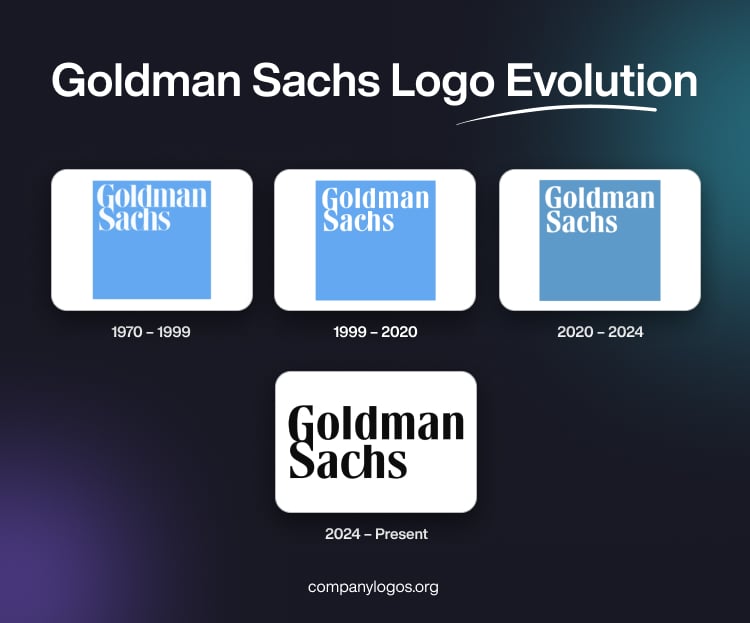
Goldman Sachs is a US-based financial institution started by Marcus Goldman and Samuel Sachs. It provides a wide range of services, such as investment banking, credit cards, securities underwriting, asset management, securities trading, risk arbitrage, financial research, and others, to institutions, corporations, government agencies or authorities, and individuals. The Goldman Sachs logo has remained almost the same since its inception in 1970, which is a testimony to its stability and effectiveness. The article delves into the evolution of the Goldman Sachs logo over the years.
The Genesis of the Goldman Sachs Logo (1970 – 1999)
In 1970, the famous blue square logo was designed by Lippincott & Margulies and featured a sky-blue square with the company’s name in a classy white serif font in two levels. The typeface was inspired by Bodoni and included distinctive ligatures. These connected the “G” and “S” as well as the “c” and “h”. This minimalist design was chosen to project confidence, trustworthiness, and clarity, and it quickly became one of the most recognisable marks in global finance.

(1999 – 2020)
In 1999, the blue square logo was subtly redesigned. The shade of blue became darker, and the wordmark in a white serif typeface was placed on the left upper part of the blue square. Some of the letters had curved tails and sharp serifs.

(2020 – 2024)
The logo underwent another update in 2020 and was led by the Dalton Maag type design studio. The blue background was made slightly duller, and the ligatures connecting the “G” and “S” and the “c” and “h” were separated to enhance legibility at smaller sizes. At the same time, Goldman Sachs introduced its own bespoke typeface, “Goldman Sans”, which was designed to unify the brand’s visual identity across all platforms.

(2024 – Present)
In August 2024, Goldman Sachs reverted to a design that reconnected the “G” and “S” and the “c” and “h” ligatures. However, some elements from the 2020 update, such as the pointed serifs on the “A” and “C”, were retained. This latest evolution in black is a blend of tradition and modernity.

The Elements of the Goldman Sachs Logo
Font
The Goldman Sachs wordmark in lowercase is written using a custom typeface combining both serif and sans serif letters. Further, for various media, fonts such as Sabon, Univers, and Roboto are used.
Colour
The colour scheme used to design the Goldman Sachs logo uses both light blue and white. Here, blue conveys the optimistic attitude of the company towards life and work, while white stands for purity, fairness, and lawfulness.
The History of Goldman Sachs
Goldman Sachs was founded in 1869 by a German immigrant, Marcus Goldman, in a modest one-room basement office at 30 Pine Street in New York City. Initially, Goldman specialised in commercial promissory notes that provided short-term financing to local merchants during a period when bank credit was scarce and expensive. His innovative approach of purchasing promissory notes from merchants and selling them to New York banks—quickly established his reputation for reliability and financial acumen.
In 1882, Marcus Goldman’s son-in-law, Samuel Sachs, joined the business, and by 1885, Henry Goldman (Marcus’s son) and Ludwig Dreyfuss (another son-in-law) had also become partners. The firm was then renamed Goldman, Sachs & Co. By 1898, Goldman Sachs’s capital had grown to $1.6 million, and the company had expanded with new offices in Boston and Chicago by 1900.
Goldman Sachs was the pioneer in the use of commercial paper for entrepreneurs, which became a critical financing tool for businesses with few hard assets. In 1896, the firm joined the New York Stock Exchange and established its status as a leader in business financing within the German American and Jewish American banking communities.
A major milestone came in 1906 when Goldman Sachs entered the initial public offering (IPO) market by taking Sears, Roebuck and Company public. It was a deal that was facilitated by Henry Goldman’s personal friendship with Sears co-owner Julius Rosenwald. The firm continued to innovate and established the price-earnings ratio as a method for valuing companies. This allowed it to raise capital for retailers and other businesses.
In 1912, Henry S. Bowers became the first non-family partner, which marked a shift toward a broader partnership structure. However, in 1917, Henry Goldman resigned due to internal pressure over his pro-German stance during World War I. Thereafter, the Sachs family gained full control until the arrival of Waddill Catchings in 1918. The firm’s aggressive expansion led to the creation of the Goldman Sachs Trading Corporation in 1928. It was a closed-end fund that collapsed during the 1929 Wall Street Crash and damaged the reputation of the firm amid accusations of price manipulation and insider trading.
In 1930, Sidney Weinberg became senior partner and shifted the firm’s focus from trading to investment banking. Thereafter, the firm established an investment research division and a municipal bond department. Under Weinberg’s leadership, Goldman Sachs became a key player in risk arbitrage and helped the firm weather the Great Depression better than many of its peers.
The mid-20th century saw further expansion. The firm opened its first international office in London in 1970, followed by Tokyo and Zurich in 1974. Goldman Sachs continued to innovate and expand and established itself as a leading investment bank in the United States and outside. In the 1980s, the firm merged with Drexel Burnham Lambert’s investment banking arm, which further boosted its global reach.
By the 1990s, Goldman Sachs had consolidated its status as a preeminent leader in the financial services industry. It began to be widely known for its expertise in investment banking, securities trading, asset management, and financial advisory services. A transformative moment came in 1999 when Goldman Sachs became a publicly traded company. This accelerated its international growth and broadened its access to capital markets. The firm diversified into new areas, including private equity, hedge funds, and, later, online banking through Goldman Sachs Bank USA.
Despite its successes, Goldman Sachs has faced significant challenges as well. These include scrutiny during the 2008 financial crisis and reputational setbacks in the late 2000s. The firm responded with new initiatives, such as the “Returnship” programme in 2008 to support professionals returning to work after career breaks.
Goldman Sachs remains a dominant force in global finance and has been ranked consistently among the world’s largest investment banks. It serves as a market maker, asset manager, and advisor to corporations, governments, and individuals worldwide. Goldman Sachs is renowned for its influential alumni network, with many former executives holding prominent roles in government and public service. The firm’s culture of innovation, adaptability, and resilience has enabled it to navigate financial crises and maintain its position as a systemically important financial institution.
Today, Goldman Sachs operates from its headquarters in New York City. It has regional offices in major financial centres around the globe and continues its legacy as a pioneer and leader in the financial industry.
Interesting Facts About Goldman Sachs
- Goldman Sachs was founded in 1869 by Marcus Goldman, a German immigrant. He started the firm in a one-room basement office in New York City next to a coal chute.
- Goldman Sachs pioneered the commercial paper business by offering local merchants an alternative to expensive bank credit. It did so by purchasing their promissory notes and selling them to banks.
- The firm got its name when Marcus Goldman’s son-in-law, Samuel Sachs, joined in 1882. He was followed by his son Henry Goldman and another son-in-law, Ludwig Dreyfuss, in 1885 to form Goldman, Sachs & Co.
- Goldman Sachs was an early innovator in valuing companies based on earnings and goodwill rather than just physical assets. It popularised the price-to-earnings (P/E) ratio as a valuation metric.
- In 1906, Goldman Sachs managed its first initial public offering (IPO) for Sears, Roebuck and Company. In doing so, it broke new ground in equity and debt securities underwriting.
- The firm expanded nationally and internationally early on by opening offices in Boston, Chicago, San Francisco, Philadelphia, and St Louis by 1920. It established relationships with financial firms in major European capitals by 1897.
- Sidney J. Weinberg, aka “Mr Wall Street”, led the firm as senior partner from 1930 to 1969. He guided Goldman Sachs through the Great Depression and helped position it as a leading full-service investment bank.
- Goldman Sachs pioneered block trading in the 1970s, which enabled large equity trades to be executed without disrupting market prices.
- The firm opened its first overseas office in London in 1970, followed by Tokyo and Zurich in 1974.
- Goldman Sachs became a publicly traded company in 1999 and was listed on the New York Stock Exchange under the ticker symbol GS.
- In response to the 2007–08 financial crisis, Goldman Sachs converted from an investment bank to a bank holding company. This made it eligible for federal emergency programmes like TARP.
- The firm launched philanthropic initiatives such as 10,000 Women (2008) and 10,000 Small Businesses (2009) to support entrepreneurs and small business owners worldwide.
- Goldman Sachs partnered with Apple to launch the Apple Card in 2019. It was a credit card integrated with the iPhone Wallet app, which showcased the firm’s move into consumer finance and technology.
- The firm has a strong tradition of innovation in risk management, securities underwriting, and financial research and often sets industry standards.
- Goldman Sachs is consistently ranked among the largest and most influential investment banks globally. As of 2024, it is 55th on the Fortune 500 list.
Finally
The Goldman Sachs logo stands as a symbol of stability, consistency, reliability, and adaptability—qualities that have defined the firm’s identity through generations. Besides, the minimalism displayed in the logo conveys a feel of the logo being clean and uncluttered. The logo changes reflect a renewed emphasis on the firm’s legacy and partnership culture.